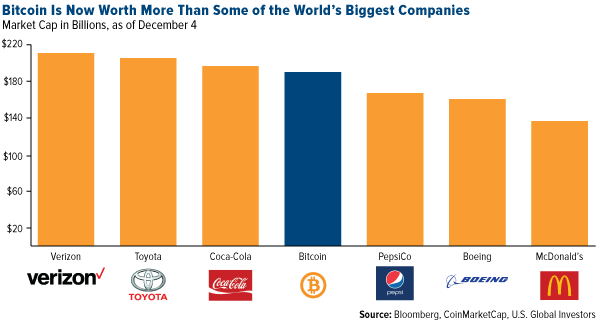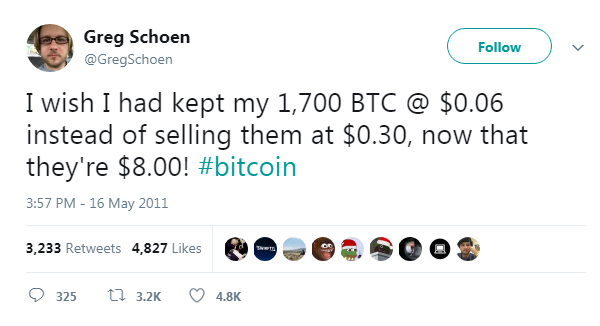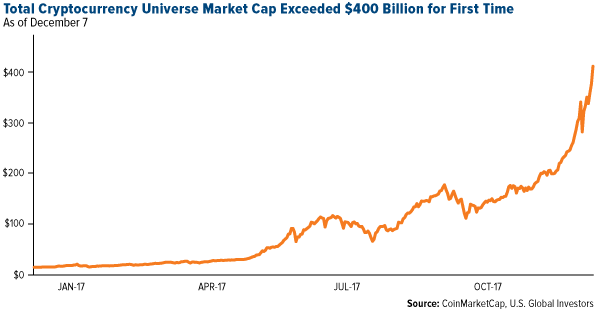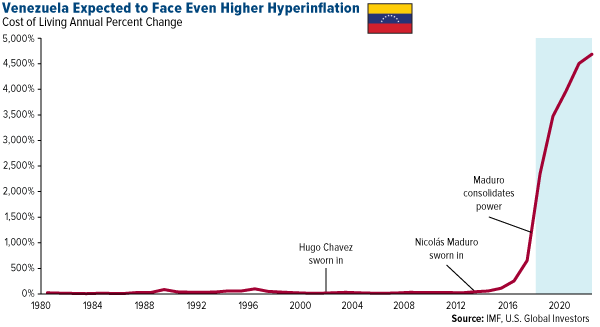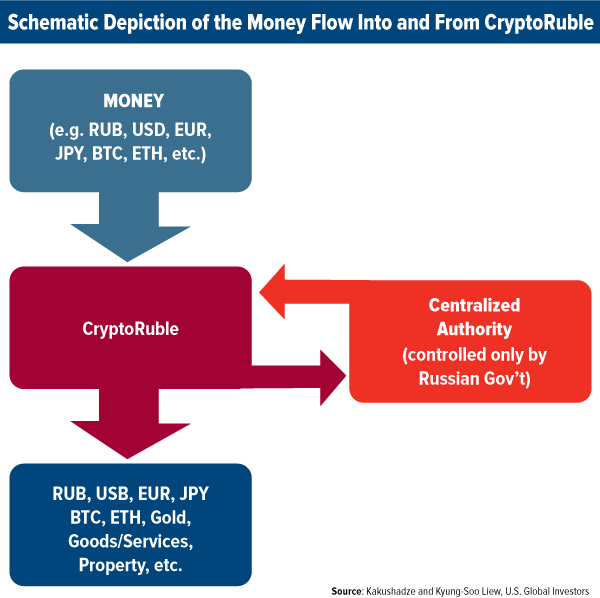Currency


Bitcoin has been the headline item in recent weeks. Its pace has surpassed the gold and silver run of 1979-80 and the NASDAQ of 1999. But it is not unlike the real high-fliers of the Dotcom mania. A realistic comparison of Bitcoin is best done with Qualcomm of 1999.

The key lows in QCOM had been $2.36 in 1998 (42x move to $100), $0.92 in 1994 and $0.40 in 1992 (250x move to $100).
If the next consolidation in Bitcoin holds above $11,000 then we could be looking at a double from the corrective low.
The following charts display the dynamic action of investment vehicles in the sector during the last six months. Regardless of the extent of the upside moves, most have provided corrections back below their 20-day exponential moving averages, frequently testing the 50-day average.
Opinions in this report are solely those of the author. The information herein was obtained from various sources; however, we do not guarantee its accuracy or completeness. This research report is prepared for general circulation and is circulated for general information only. It does not have regard to the specific investment objectives, financial situation, and the needs regarding the appropriateness of investing in any securities or investment strategies discussed or recommended in this report and should understand that statements regarding future prospects may not be realized.
Investors should note that income from such securities, if any, may fluctuate and that each security’s price or value may rise or fall. Accordingly, investors may receive back less than originally invested. Past performance is not necessarily a guide to future performance. Neither the information nor any opinion expressed constitutes an offer to buy or sell any securities or options or futures contracts. Foreign currency rates of exchange may adversely affect the value, price or income of any security or related investment mentioned in this report. In addition, investors in securities such as ADRs, whose values are influenced by the currency of the underlying security, effectively assume currency risk. Moreover, from time to time, members of the Institutional Advisors team may be long or short positions discussed in our publications.
BOB HOYE, INSTITUTIONAL ADVISORS

 Bitcoin has replaced gold as the hot anti-establishment medium which has been gaining momentum. In light of India canceling their currency, there is a growing position against government currencies. This is certainly part of the entire shift from a Public to a Private Wave on the Economic Confidence Model. The overall confidence in government has been declining significantly on economic and political levels – i.e. the election of Trump, BREXIT, and Merkel collapsing to 32.5%.
Bitcoin has replaced gold as the hot anti-establishment medium which has been gaining momentum. In light of India canceling their currency, there is a growing position against government currencies. This is certainly part of the entire shift from a Public to a Private Wave on the Economic Confidence Model. The overall confidence in government has been declining significantly on economic and political levels – i.e. the election of Trump, BREXIT, and Merkel collapsing to 32.5%.
In a purely economic sense, Bitcoin is really the medium of exchange in a barter situation. That is what BARTER was all about. It was some object that was recognized as acceptable among a group of traders so it becomes the medium of exchange. The problem with Bitcoin is that it is limited and therefore does not represent a true currency that many expect to compete against the government when there is not enough to go around for everyday use among the people.
….also from Martin:

Wow. Just….wow.
Bitcoin’s price has gone ‘beyond exponential’ this week. As I started working on this article, it shot up 22% — from $14,000 to $17,000 (hitting an intraday high of over $19,000).
And that’s after a mind-blowing upwards rocket ride over the past several months.
I think it’s safe to say that the vicious melt-up in price over such a short timeframe has surpassed the expectations of even the starriest-eyed Bitcoin fanboys.
The whole world, especially the 99.99% of us that own zero cryptocurrency, is asking: What happens next? And, What should I do?
Is this insane trajectory going to continue for a lot longer? Do I need to get in now to avoid missing this once-in-lifetime fortune-making opportunity?
Or is this a classic bubble blow-off top? Is this the deadliest time to enter, right before the price implodes?
An Expert’s Take
…also:
Davefairtex, our resident charting expert, notes that his model now shows Bitcoin’s level of overvaluation at “nosebleed” levels with a daily RSI of over 98 and the forecaster clearly predicting a reversal:


QUESTION: You have said that coins were still fiat and not tangible hard money. Nobody else has said that. Can you support that statement?
DS
ANSWER: Of course. During the American Colonial period, there was a shortage of silver in particular in Britain. The British imposed restrictions on what coins could be used to pay Americans for anything. That restriction was imposed on silver and gold. Therefore, payment to Americans from Britain was always in copper coins. If Americans wanted to buy something from Britain, it was typically demanded in silver or gold. This was one of the reasons for the American Revolution.

Because of these restrictions, the monetary value of copper coins was twice its actual metal content. All governments produced coins ONLY at a profit, which is called the seignorage..……
….also from Martin:
EU Commission v Eurogroup
Most people do not understand that there is the Eurogroup, which is an informal body of finance ministers from the Eurozone member states that are intended to discuss matters relating to their countries’ common responsibilities related to the Euro. They do not keep any minutes so nothing emerges with respect to policy. There is now a clash building between this Eurogroup and that of the European Commission….


Writing about blockchain and bitcoin right now is a little like buying a new computer in the 1990s. The tech was advancing so fast in those days that as soon as you brought the thing home, it was sorely outdated. Similarly, the cryptocurrency world is changing so rapidly at the moment that even before “the ink dries” on one of my posts, some important new development has already surfaced.
Case in point: When Bloomberg ran a particular story last Monday—“Bitcoin Is Now Bigger Than Buffett, Boeing and New Zealand”—bitcoin’s market cap hovered just above $185 billion, making it worth more than the likes of PepsiCo, Boeing and McDonald’s.
Well, here it is a week later, and this chart is already outdated. As of Monday morning, bitcoin’s market cap topped $275 billion, bringing its total value comfortably above Coca-Cola, Toyota and Verizon (and now Bank of America, Walmart, Procter & Gamble, Pfizer, AT&T and Chevron). Next stop is Alphabet, which had a market cap of $288 billion at the end of the third quarter.
Or consider this: In May 2011, an early bitcoin investor named Greg Schoen tweeted his regret that he sold at $0.30, as the currency had then risen to $8.00 apiece.
Obviously we’ve seen earth-shattering appreciation since then. As of my writing this, bitcoin has breached the $17,000 level, up nearly 5.6 million percent—yes, you read that right, 5,600,000 percent—from our friend Greg’s exit point in 2011.
Bitcoin, of course, is just the largest fish in the entire universe of cryptocurrencies, which now number somewhere in the vicinity of 1,340, according to CoinMarketCap. If we combine the total market cap of all “altcoins” Monday morning, the amount exceeded $440 billion. That’s larger than the economies of Thailand, Nigeria and Austria. As of my writing this, as many as 15 coins had market caps over $2 billion.
Coinbase Now Has More Accounts Than Charles Schwab
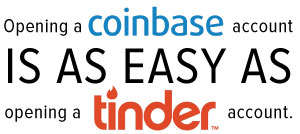 |
This meteoric growth has attracted not just retail investors but also, inevitably, regulators. San Francisco-based Coinbase, which allows users to trade digital currencies, now boasts more active users than fellow San Francisco-based Charles Schwab, the second biggest brokerage firm following Fidelity. As of December 1, Coinbase had 13 million accounts, Schwab 10.6 million.
Contributing to Coinbase’s attractiveness is the ease with which someone can join. Whereas it can take up to two weeks to create a Schwab account, a Coinbase account can be opened in mere minutes, and as effortlessly as a Tinder account. This is one of the many reasons why both the popular online trading platform and dating service appeal to millennials.
According to Coinbase, as much as $50 billion have been traded on its platform since its inception, but as the number of accounts grows, we’ll likely see this dollar figure surge exponentially. This is the effect of Metcalf’s law, which I featured in an earlier post and discussed with SmallCapPower during the Mines and Money conference in London last month.

The Rule of Unintended Consequences
If you recall, President Reagan once said: “Government’s view of the economy could be summed up in a few short phrases: If it moves, tax it. If it keeps moving, regulate it. And if it stops, subsidize it.” Surprising no one, then, Coinbase’s success has raised alarm bells for regulators and other government officials.
Ironically, it’s regulators that have unintentionally created the current environment in which cryptocurrencies now thrive. Back in May, I shared with you the fact that the number of listed companies here in the U.S. fell by more than half between 1996 and 2016. The addition of new financial rules and regulations, from Sarbanes-Oxley to Dodd-Frank, has encouraged more and more startups to avoid going public altogether, which is why we’re seeing an explosion right now in both stock prices—fewer listed companies means greater consolidation of fund flows into select stocks—and nontraditional methods of fundraising, from initial coin offerings (ICOs) to angel investing.
 |
Consider the unintended consequences of Prohibition. Thanks to the 18th Amendment, the U.S. saw a sharp rise in organized crime and the emergence of notorious figures such as Al Capone.
By invoking “Scarface,” I’m not suggesting that all activities involving cryptocurrencies are illegal or malicious. I’m only saying that when rules and regulations become too restrictive, it invites new opportunities in unexpected ways.
And the beat goes on. After a months-long pushback, Coinbase agreed at the end of November to turn over the identities of 14,000 of its users to the Internal Revenue Service (IRS), which asserted that only 800 to 900 taxpayers reported bitcoin earnings between 2013 and 2015.
The tax agency initially requested access to all 13 million of Coinbase’s users, so I would call this an overall win for the exchange.
Bad News Is Good News
You might presume the IRS’ crackdown on Coinbase would discourage some potential bitcoin investors from participating. I would argue that the IRS incident is actually constructive for bitcoin because there’s very recent precedent of similar setbacks being turned into a windfall for digital currencies.
In mid-September, we saw the price of bitcoin dip sharply after China restricted new ICOs and JPMorgan Chase CEO Jamie Dimon knocked the digital currency as a “fraud,”comparing it to the Dutch tulip bubble in the 17th century. The one-two punch purged the market of weak-stomached investors, resulting in an intraday loss of $711 per coin.
Since mid-September, though, bitcoin has rallied close to 380 percent, even after the IRS came for its pound of flesh. On November 29, bitcoin swung wildly from as high as $11,427 to as low as $9,001, a difference of $2,426.
Those who managed to tolerate these swings in the past will likely continue to stay aboard the S.S. Bitcoin—after all, the big banks and IRS’ opposition to digital currencies is precisely why they’re in the game in the first place. Bitcoin enthusiasts value the currency because it’s decentralized, anonymous, finite and cannot be manipulated by “the powers that be,” unlike fiat money.
Put another way, that some world governments, big banks and the IRS seek to quash bitcoin is unequivocal confirmation of its value.
If You Can’t Beat Them, Join Them
That brings us to Venezuela’s recent announcement that it plans to launch its own cryptocurrency, dubbed the “petro,” which will reportedly be backed by oil, gold and diamond reserves.
The revelation comes as the beleaguered South American country’s economy continues to deteriorate since Nicolás Maduro took office in 2013. The country owes around $60 billion to bondholders yet has only $9.6 billion sitting in the bank. An estimated 80 percent of Venezuelans currently live in poverty. Food, medicine and other necessities are dangerously scarce, and inflation right now is among the worst the world has ever seen, comparable to Germany in the 1920s and Zimbabwe in the 80s.
This is inexcusable for such a resource-rich country. Venezuela, which depends on oil for around 95 percent of its export revenues, sits atop the world’s largest known oilfield. Amazingly, though, its output has been declining for several straight months. In September, production fell below 2 million barrels a day, a three-decade low, according to the Organization of Petroleum Exporting Countries (OPEC).
Conditions aren’t likely to improve for the country since Maduro consolidated power in July,effectively making himself absolute dictator and inviting harsh economic sanctions from the U.S. government.
This is precisely what drives Maduro’s interest in establishing a cryptocurrency—to circumvent U.S.-led sanctions. The petro will serve as a “buffer” between transactions, encrypting all incoming and outgoing money to free up the country’s monetary system from controls imposed by the U.S.
As explained by Bloomberg’s Leonid Bershidsky, foreign investors “will be able to lend money to Venezuela and get repaid in cryptocurrency, which Maduro wants them to spend on oil and other Venezuelan commodities” that are tied up by the U.S.
Russia has similar ambitions with its “CryptoRuble,” unveiled in October. Like Venezuela, Russia grapples with steep U.S. and international sanctions following its annexation of Crimea in 2014 and meddling in the 2016 U.S. election. Below is a flowchart— courtesy of Zura Kakushadze, professor of quantitative finance at Free University of Tbilisi, and Jim Kyung-Soo Liew, assistant professor of finance at John Hopkins University—illustrating how the CryptoRuble is designed to allow the Russian government to maintain full control of money flow into and out of the country’s coffers.
According to Kakushadze and Kyung-Soo Liew:
With government-issued cryptocurrencies, central banks and sovereign governments will gain even more control, not less, than with the current banking system… This is any government’s dream come true!
To be clear, the way in which Venezuela and Russia plan to use cryptocurrencies is antithetical to their appeal in the eyes of many investors. Unlike bitcoin, Ethereum, Litecoin and other popular digital currencies, the petro and CryptoRuble are centralized—they are conceived and will be controlled exclusively by the Venezuelan and Russian governments.
And unlike bitcoin, they will not be mined, as gold is, but issued by governments, as fiat money is.
Again, Kakushadze and Kyung-Soo Liew:
The world order as we know it is changing, right before our eyes. This disruptive technology—cryptocurrencies—will indeed end up disrupting the status quo. However, at least in the mid-term, forward-thinking sovereign states that embrace and adapt it to their advantage will end up being the disruptors as opposed to disrupted. The U.S. is the sovereign state with the most to lose in their process, with a clear policy implication: adapt to the changing reality, issue CryptoDollars now, or risk being marginalized.
This assessment dovetails perfectly into a November report from Deutsche Bank strategists Jim Reid and Craig Nicol, who reflect on what they see as the end of traditional fiat money within the coming decades. Because fiat currencies are “inherently unstable and prone to high inflation,” Reid and Nicol write, “We may need to find an alternative.” Among other solutions, the two suggest cryptocurrencies, which “are as much about blockchain as anything else.”
Speaking of blockchain, Australia’s main stock market, the Australian Securities Exchange (ASX), is soon poised to become the first in the world to use blockchain’s superior ledger technology to process transactions, according to Bloomberg. It wouldn’t surprise me if other global stock markets, including the New York Stock Exchange (NYSE), quickly embraced this exciting new technology.
How to Gain Exposure to Bitcoin Without Owning Any
And finally, both the Chicago Board Options Exchange (CBOE) and the Chicago Mercantile Exchange (CME) have set the table to offer bitcoin futures contracts for the first time ever this month—the CBOE this past Sunday, the CME a few days later. This will give investors a new way to participate in bitcoin and, in many skeptics’ minds, help “legitimize” the currency as a serious asset.
There are other ways to participate without actually owning bitcoin. In a recent Bloomberg story, Tom Lee of market research firm Fundstrat lists several companies and funds with exposure to the digital currency. Among his favorites is HIVE Blockchain Technologies, a blockchain infrastructure company involved in the mining of fresh new coins, never before traded. The first company of its kind to sell shares to the public, HIVE began trading on the TSX Venture Exchange on September 18.
I’m sure I’ll have more to say on these topics at a later time. In the meantime, I invite you to watch this short, 16-minute film titled “Cryptocurrency Revolution: On the Frontlines of the World’s Hottest Tech Opportunity.” It features myself, Frank Giustra and Marco Streng, co-founder and CEO of Genesis Mining, the world’s largest cloud bitcoin mining company.
All opinions expressed and data provided are subject to change without notice. Some of these opinions may not be appropriate to every investor. Some links above may be directed to third-party websites. U.S. Global Investors does not endorse all information supplied by these websites and is not responsible for their content.
Holdings may change daily. Holdings are reported as of the most recent quarter-end. The following securities mentioned in the article were held by one or more accounts managed by U.S. Global Investors as of (09/30/2017): The Boeing Co., Chevron Corp.
Frank Holmes has been appointed non-executive chairman of the Board of Directors of HIVE Blockchain Technologies. Both Mr. Holmes and U.S. Global Investors own shares of HIVE, directly and indirectly.



